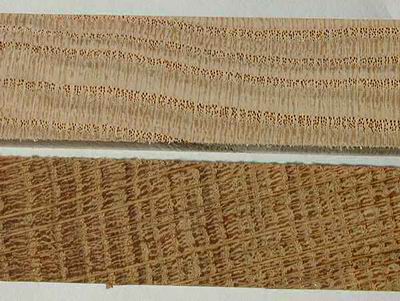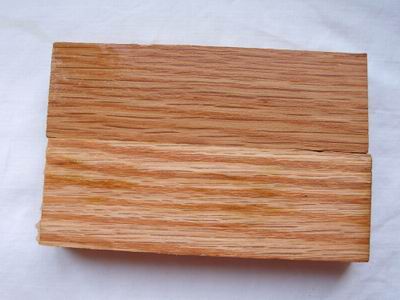Distinguishing White Oak from Red
Other Versions
Spanish
Methods for discerning different oak types. May 19, 2004
Question
I have recently come into 14,000 bft of rough cut lumber. The red and white oak is all mixed. Is there a quick way to tell the two apart without surfacing a section?
Forum Responses
(Sawing and Drying Forum)
One is white and one is red. You'll be able to tell the red oak from the white when you cut longitudinally. Red oak looks red.
Or cut off a short soda-straw sliver and try to blow bubbles with it in a glass of water. Red has no blocking tyloses and you'll get some bubbles.
When you look at oak from the end of the board, you can tell the difference. Red oak looks like a bunch of little straws around the growth rings and white oak looks solid. Same on the face of the boards. Once you see the difference it is easy to pick out.
From Gene Wengert, forum technical advisor:
There is some incorrect information posted above.
Red oak is not always more red than white oak. For example, black oak (which is a red oak) has no red at all. Color is about 50% accurate.
Although red oak will let you blow bubbles, so will some white oak. This test is not too good. Red oak growing under stress will not let you blow bubbles.
There is a test where you put a few drops of sodium nitrite solution on the oak and if it turns dark colored, it is white oak. This test is 100%.
You can separate most white from red by noticing the ray length in the flatsawn portion of the lumber, even on rough lumber. Once someone shows you this technique, it is pretty easy. Most lumber graders and others with experience with both groups of oak can separate them easily.
Identification is very easy in this part of the country by looking at the end grain. In the picture, the top slice is red oak and the bottom is white oak. Red oak grows fast in this part of the country and will normally have 4 to 6 rings to the inch while white oak is a slow grower with 10 to 20 rings to the inch. Tyloses are more open on the red oak. Rays are a lot more prominent on the white oak. This may not be a good indicator in other parts of the country, though.

I infer from your post that if the lumber was surfaced, you could differentiate between white and red oak. If deciphering rough sawn oak species is the problem, I suggest you contact a lumber grader at a local sawmill and offer to buy him/her lunch on a Saturday in return for giving you a quick lesson in how he/she differentiates rough sawn white oak from red oak. Failing that, Dr. Wengert has you on the right track with ray length. If the rays average more than 3/4", it's white oak. White oak's distinctively long rays are why Gustav Stickley favored quartersawn white oak for his "craftsman" style furniture.
From the original questioner:
Is sodium nitrate easy to come by? It seems like a good way to get me through until my eye becomes better trained.
From Gene Wengert, forum technical advisor:
Use a 5% sodium nitrite (not nitrate) solution in tap water.
Here is a piece of red oak and a piece of white oak. Can you tell which is which? Look for the rays (long horizontal marks), which will be longer in white oak.

Where could a guy easily find some sodium nitrite? Not for sure if hotdogs at the store would have enough chemical to do the job but maybe canning salts? Pretty hard to tell the difference visually between white oak and red oak on timbers out of an old barn. I re-saw them occasionally. I like your test!
From Gene Wengert, forum technical advisor:
Canning salts are nitrates; nitrite is a little different. Ask at your local pharmacy. Do not get more than you need, as you would have to have it labeled, and consumer info sheet, etc. to be legal. Unmarked and undocumented bottles, etc. are illegal, according to OSHA, and could be unsafe (if someone accidentally spilled or drank some and no one knew what it was).
Gene, I'm confused about a comment you made about black oak. We get black oak in from SE Nebraska, and cut it up mostly for pallet, although we do get some grade. It is about the same pink as red oak, or maybe slightly darker. Farther south in Kansas, the black oak has a definite redder color. At least this is what all the loggers call black oak. Is it actually another type of oak we are cutting?
I worked with a company in Western PA that pulled out the black oak because it needed a milder schedule. It was the reddest stuff you ever saw.
From Gene Wengert, forum technical advisor:
Not all black oak is so red, apparently. There are 20 species of oaks in the red oak grouping. Some are red and some are not. Perhaps it depends on the soil?
I was concerned about the comment concerning black oak in Kansas... At best, Kansas is on the very edge of the species, which means that it will likely be different in many properties or that what is called black oak by the natives is actually another species. Black oak does cross easily with northern red oak and perhaps this cross is what gives the wood its red color. The same would be true in parts of PA.
Note that California black oak is a different species.
I am a grader in Missouri, and work behind the planer in a large flooring plant. I have found that as the boards pass me on the chain, the easiest way to pull the white oak is by putting it between some red oak. If you scan from right or left through the three boards you will see the difference, though sometimes subtle, in the white oak. With practice it gets easier.
The comments below were added after this Forum discussion was archived as a Knowledge Base article (add your comment).
Comment from contributor N:
Another way to tell white oak from red oak is the smell. White oak has a sweet smelling scent, where red oak does not. The scent is most noticeable when you make a crosscut and put your nose to it. Once you smell white oak, you won’t forget it. I also agree with the poster who included the pictures of the end grain oaks in this article. This is another great way to distinguish the two.

